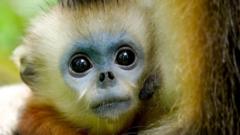Can China's Rare Snub-Nosed Monkey Be Saved?

Published: 2025-08-26 22:35:21 | Category: technology
Efforts to protect the endangered golden snub-nosed monkeys in Shennongjia, China, have led to a remarkable recovery from near extinction. With a population that plummeted below 500 due to habitat destruction and hunting, dedicated conservationists like Professor Yang Jingyuan have played a crucial role in restoring their numbers to over 1,600 today. This article delves into the history, challenges, and successes of the conservation initiatives that have shaped the future of this unique species.
Last updated: 22 October 2023 (BST)
Key Takeaways
- The golden snub-nosed monkey population fell below 500 due to habitat destruction and hunting.
- Conservation efforts led by Professor Yang Jingyuan have increased their numbers to over 1,600.
- Community involvement and education have been vital in changing local attitudes towards wildlife preservation.
- Golden snub-nosed monkeys have complex social structures and reproductive challenges.
- Tourism is growing, but strict protections are in place for their habitats.
The Decline of the Golden Snub-Nosed Monkey
The golden snub-nosed monkey (Rhinopithecus roxellana) is a primate species endemic to the mountainous regions of central China. Historically, these monkeys faced severe threats due to extensive logging, hunting, and habitat loss, particularly throughout the 20th century. The situation worsened until the 1980s, when the population dwindled significantly, making the species one of the most endangered primates in the world.
Environmental Impact and Loss of Habitat
As farmers cleared vast areas of forest for agriculture and logging, the monkeys' natural habitat was decimated, leading to a rapid decline in their numbers. By the time Yang Jingyuan entered the scene in 1991, only a few hundred remained.
Yang recalls, "The monkeys' home was being destroyed by logging, so their numbers were going down fast." This environmental degradation not only threatened the monkeys but also the livelihoods of local communities that relied on the forest for sustenance.
Conservation Initiatives Begin
In 1982, Shennongjia National Park was established to protect the region's biodiversity, but it would take years for real change to occur. Local ranger Fang Jixi recounts the struggles of the past: "People were very poor in these mountains, and hunger was a real concern. There was no concept of protecting wild animals." Even after logging was banned, illegal activities persisted as desperate farmers sought to support their families.
Transforming Attitudes
To combat this issue, conservationists recognised the necessity of involving local communities in preservation efforts. Education initiatives were launched to raise awareness and change perceptions about wildlife conservation. Professor Yang's team worked closely with farmers, encouraging them to become protectors of the forest rather than destroyers.
"When the change occurred, it was the scientists who told us you can actually come and work with us," said Mr Fang. This collaborative approach not only fostered a sense of ownership among locals but also provided new job opportunities that helped reduce reliance on destructive practices.
Understanding the Golden Snub-Nosed Monkey
As conservation efforts gained momentum, researchers began to study the behaviour and social structures of the golden snub-nosed monkeys. Prof Yang, now the director of the Shennongjia National Park Scientific Research Institute, has devoted his life to understanding these fascinating primates.
Complex Social Structures
The social structure of golden snub-nosed monkeys is intricate and fascinating. Typically, a family group consists of one dominant male and several females, along with their offspring. These family groups often band together to form larger troops, which can number over a hundred individuals. Interestingly, bachelor males form their own groups, sometimes playing a role in guarding the troop.
Prof Yang explains, "Females have 'affairs' behind their husband's backs, causing tension and fights." This social complexity extends to their reproductive habits, as females only give birth once every two years, with not all offspring surviving, posing an additional challenge to population recovery.
Communication and Behaviour
One remarkable aspect of these monkeys is their vocal communication. Prof Yang has developed an understanding of their calls, noting that different sounds convey various messages. For instance, a "Yeeee" indicates safety, while "Wu-ka" warns of danger. This ability to communicate with the monkeys has fostered a unique bond between them and the researchers.
Successful Conservation Efforts
The turning point for golden snub-nosed monkeys came in 2005 when Prof Yang and his team formed a specialist study group dedicated to their conservation. Their approach involved spending a year slowly gaining the monkeys' trust, which was no small feat, as the animals initially fled at the sight of humans.
Building Trust
Through patience and perseverance, the researchers gradually closed the distance between themselves and the monkeys. Prof Yang recalls, "I was so excited because finally they had become my friends. Every day we could be together and communicate." This relationship has been pivotal in observing their behaviours and gathering vital data for conservation strategies.
Monitoring Progress and Future Prospects
Today, the golden snub-nosed monkey population has more than tripled, with estimates exceeding 1,600 individuals. Prof Yang is optimistic about the future, aiming for the population to surpass 2,000 within the next decade. "Their home is now very well protected," he states. "They have food and drink, no worries about life's necessities, and, most of all, their numbers are growing."
Challenges Ahead
Despite these successes, challenges remain. The female golden snub-nosed monkey's slow reproductive rate means that population growth is gradual. Additionally, conservation teams must continue to monitor and protect the monkeys from poaching and habitat encroachment. The growth of tourism represents both an opportunity and a risk, as increased foot traffic can disrupt these sensitive ecosystems.
Community Involvement and Ecotourism
As the golden snub-nosed monkeys thrive, the area has seen a rise in ecotourism, which can provide additional funding for conservation efforts. However, strict regulations are in place to ensure that dedicated protection zones remain off-limits to tourists. This helps maintain a safe environment for the monkeys while allowing local communities to benefit economically.
Farmers who once lived within the monkey's habitat have been relocated, often with government support. Many, like one man we spoke to, have found happiness and success running guesthouses and benefiting from the influx of tourists drawn to the area’s natural beauty.
Conclusion: A Beacon of Hope
The story of the golden snub-nosed monkey serves as a testament to the power of conservation and community involvement. The transformation of both the monkeys' habitat and the local population's attitudes demonstrates that positive change is possible through collaboration and education. As the population continues to grow, this unique species has become a symbol of hope for conservation efforts in China and beyond.
The future of the golden snub-nosed monkeys relies on sustained efforts to protect their habitat and ensure that local communities remain engaged in conservation. With strong leadership and a dedication to preserving biodiversity, the survival of this remarkable species appears brighter than ever. How can we apply these lessons to protect other endangered species globally? #WildlifeConservation #EndangeredSpecies #ProtectOurPlanet
FAQs
What is the golden snub-nosed monkey?
The golden snub-nosed monkey is an endangered primate species endemic to the mountainous regions of central China, known for its distinctive facial features and complex social structures.
What are the main threats to golden snub-nosed monkeys?
Main threats include habitat destruction due to logging, agricultural expansion, and poaching. These factors have significantly reduced their population in the past.
How has the population of golden snub-nosed monkeys changed over the years?
The population fell below 500 due to environmental pressures but has since risen to over 1,600 due to successful conservation initiatives and community involvement.
What role do local communities play in conservation efforts?
Local communities have been educated and engaged in conservation, transforming them from potential threats to protectors of the forest, which has been vital for the monkeys' recovery.
What measures are in place to protect golden snub-nosed monkeys?
Establishing protected areas, strict regulations on tourism, and ongoing monitoring by conservation teams are key measures to safeguard the habitats of golden snub-nosed monkeys.



